Different key elements can be identified in the communication process but they are interrelated and interdependent, although they will be described separately.
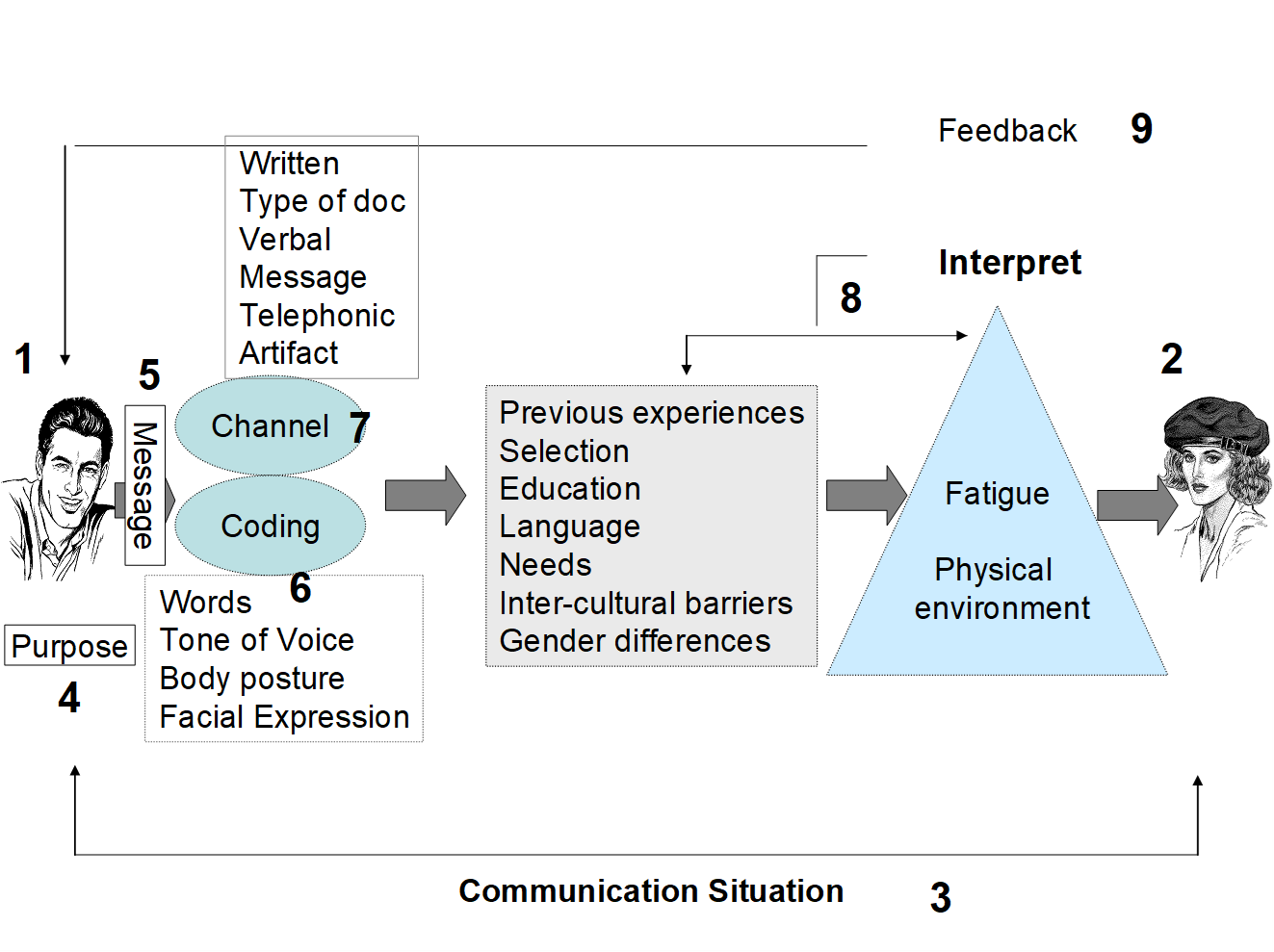
We will discuss the elements one by one.
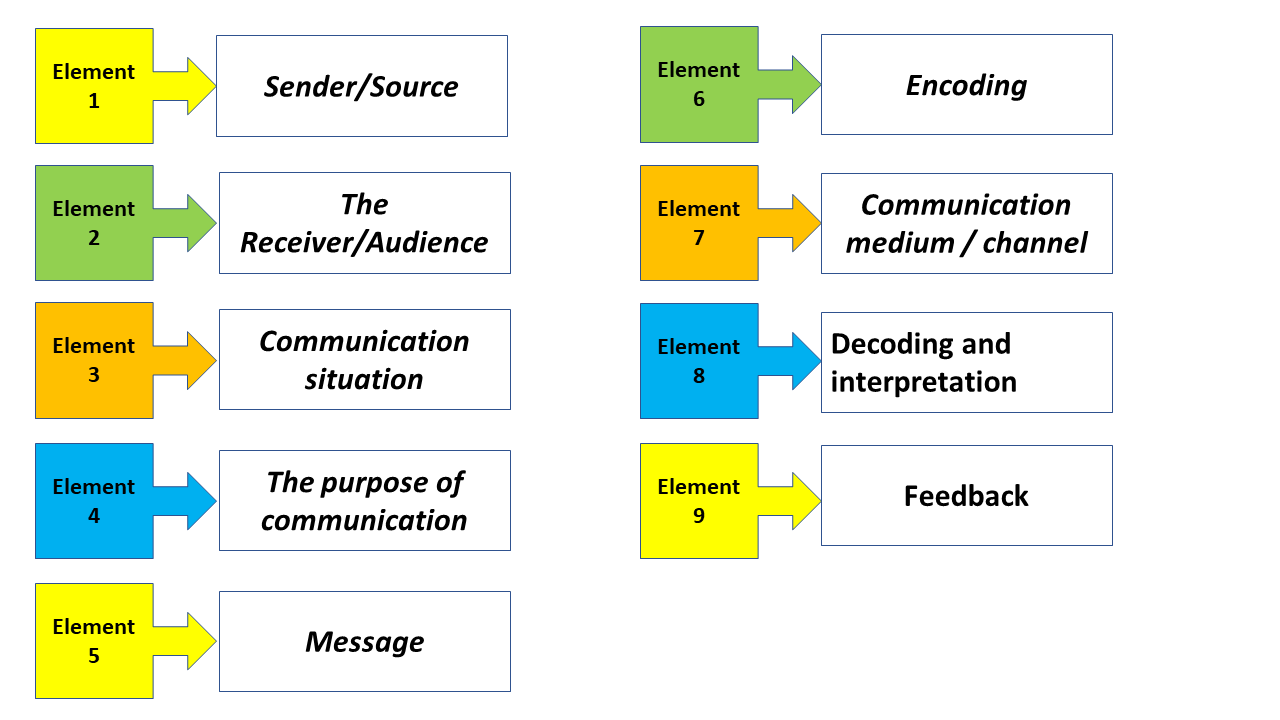
Element 1: Sender/Source
This is the person who initiates(starts) the communication by thinking of an idea to communicate to the receiver. The sender is also referred to as the source, the communicator or the encoder. We cannot put our thoughts directly in the head of the other person. As such we need to use symbols, gestures, pictures, tone of voice and words which we expect the receiver should interpret as the specific ideas that we wish to convey. This process is called encoding. The source should identify the most appropriate codes to ensure effective translation of the message. The source has the responsibility to check for understanding once the message was conveyed.
Element 2: The Receiver/Audience
The audience or receiver is the person to whom the sender directs the message and has to understand the message. Each receiver will understand the message differently because of his/her different frame of reference and perceptions.
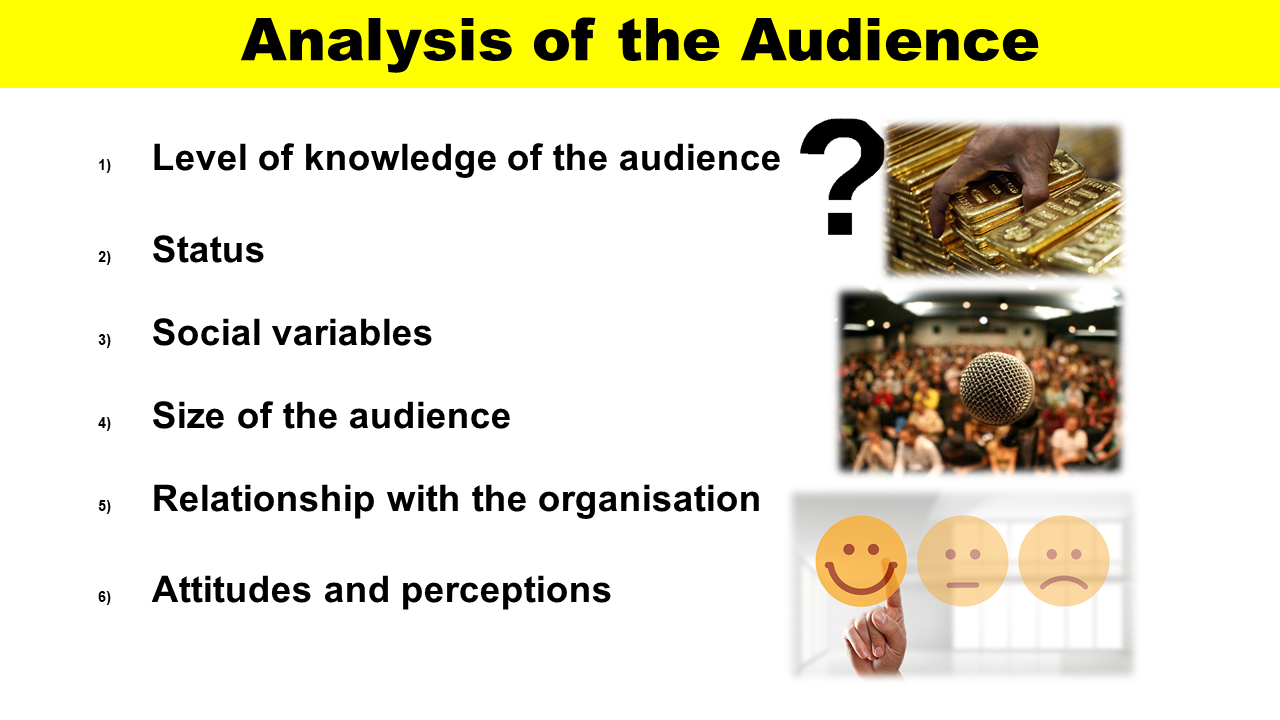
The sender has to consider the following:
Level of knowledge of the audience: What do they know about the subject? What are their perceptions of the sender and the content of the message?
Level of education: With less educated audiences, language (vocabulary and sentence construction) have to be adapted to the level of understanding of the audience.
Status: Communication has to be adjusted to the status of the receiver – compare a letter to the president to an e-mail to a friend.
Social variables: Age, gender, nationality, mother tongue, social, political, cultural beliefs, etc. have to be considered.
Size of the audience: The size of the audience will influence the communication style of the sender. Speaking or writing to one person differs dramatically from addressing 250 people.
Relationship with the organisation: Is the message intended for internal personnel or outside customers; to the CEO or to general workers...?
Attitudes and perceptions: Put yourself in the shoes of the receiver in order to be sensitive to the other person’s needs.
The receiver will decode or translate the message the source has sent to him. The receiver will consider the gestures, words, symbols etc. to come to a conclusion as to what the real message was that was sent to him/her.
The message may not be received as intended for a variety of reasons:
- The sender used inappropriate/insufficient codes,
- The channel was not effective/clear,
- Language inefficiency,
- Cultural differences, and
- The receivers belief and values distorted the meaning of the message.
Element 3: Communication situation
Communication takes place in a particular situation and refers to the time, place and circumstances in which the communication occur. The meaning of words is directly related to the situation and changes accordingly. Compare the two sentences:
“This is great!” (The boss said about a report you have written.)
“This is great!” (The boss said sarcastically about something that has gone wrong.)
Communication occurs in several kinds of contexts and is differentiated from each other according to the number of participants involved. The following contexts are identified:
Intrapersonal communication: This refers to communication within ourselves and is very important in the formation of the individual’s self-image.
Interpersonal communication: Interpersonal communication occur between two people and forms the basic unit of communication. It accounts for most of the informal everyday communication used in personal and business situations.
Small-group communication: Small-group communication refer to the communication that takes place in any organisation where people work together towards a common goal.
Public communication: Public communication refer to public speaking. It is more formal in nature and usually one-way communication as feedback is limited.
Mass communication: This refers to the transmission of a message to a mass audience. It is a one-way communication and there is no direct or personal contact with the receiver – e.g. radio, television.
Organisational communication: It can be defined as the communication between groups of people who work together to reach specific goals. In the next unit communication in the business environment will be discussed in more detail.
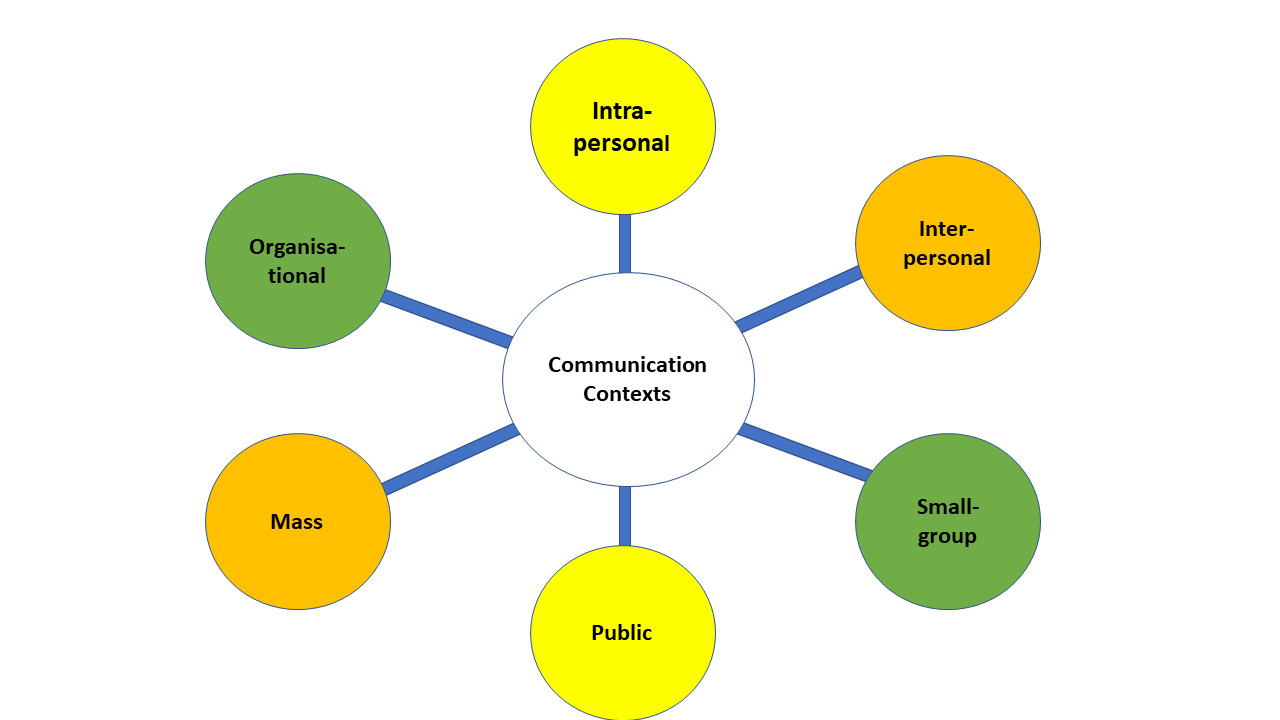
Element 4: The Purpose of Communication
Effective communication is well planned. The sender/communicator has to identify the purpose of the communication and analyse the audience. The audience can consist of any number of people.
The sender of a message has to have a clear purpose of the desired result he/she wants to achieve. Is it:
- To give information – Meeting to be held at 12:00 on 2 January 2004.
- To request information – When the meeting will be held
- To persuade – Please attend the meeting as it is of the utmost importance.
- To promote goodwill – During the meeting the CEO will discuss new remuneration options.
Element 5: The Message
The message is the content or subject matter the communicator wants to convey. For example: The message is: “Go out!” The message is a generic term that refers to any communication, spoken or written, long or short. A comment made in passing, a two line e-mail, a two hour formal presentation, a 200-page report – all are messages.
Element 6: Encoding
The sender needs to encode the message into an appropriate code before it can be sent. Encoding is the act of making an idea accessible or perceptible to the receiver. This can be done by using:
- A verbal code – any communication involving words, whether spoken or written, or
- A nonverbal code – a code without words e.g. facial expressions, gestures, etc.

The sender has to use a code that will make the message accessible(understandable) to the receiver. More than one code can be used at the same time e.g. language (words) together with body language, for example, using the word “out” together with a gesture of the hand that signals “go out”.
Language is the most commonly used code in the business and technical world. A code is a set of symbols which, when combined and used according to the rules agreed by the users, conveys meaning. The set of symbols used in language is the alphabet. The letters in the alphabet are combined according to rules to form words, the words are combined according to rules to form sentences and so meaning is conveyed.
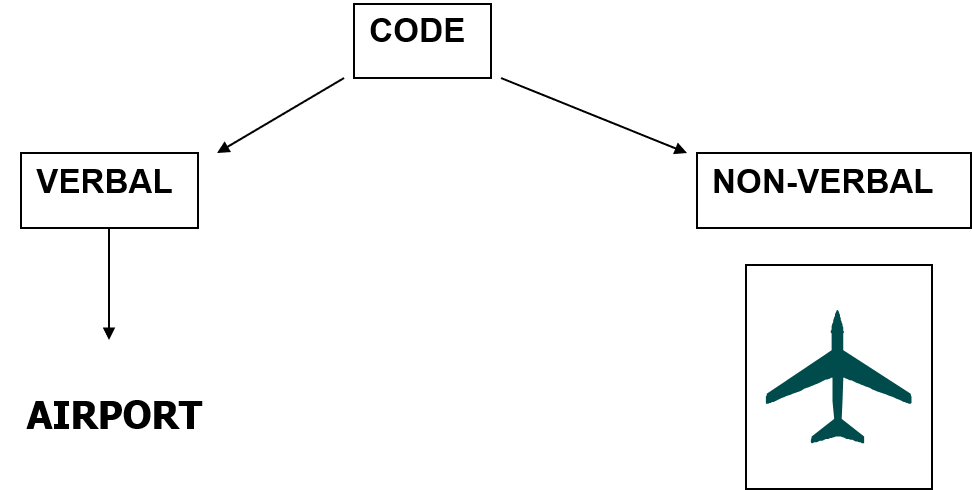
The same letters can be combined differently to form words with different meanings for example:
Mean Name Mane Amen
But the same letters combined differently do not convey meaning for example:
Nema Eman Mena Anem
The same applies to sentence construction. By changing the sequence of words numerous different meanings can be constructed. It is therefore essential to follow the rules of the language. Every language has its own set of rules.
Language, both spoken and written, is referred to as a verbal code and all other non language codes are referred to as nonverbal codes. Verbal and nonverbal codes can convey the same idea.
Language is not the only code we use to communicate. The clothes we wear, body language, colour and pictures all convey meaning. The effectiveness of the message will depend largeley on the correct choice of code. For example, when communicating to illiterate people you cannot use verbal written language, you have to use nonverbal codes e.g. pictures.

Element 7: Communication Medium/Channel
The communication channel is the medium through which the message travels. The message must be conveyed to the receiver in a concrete form.
The choice of channel e.g. telephone, e-mail, face to face communication is very important in getting the message across. Electronic media no longer make it necessary for people to be at their work stations or desks all the time because they can be reached via cell phones or pagers. Networked computers make organisational boundaries less relevant because employees can jump vertical levels much easier.
Why do people choose one channel over another? Time and cost are factors but communication apprehension or anxiety also plays an important part. People may be afraid to speak in front of a group, or use the telephone, or they are not comfortable with writing letters or memos. People will avoid situations where they have to use a certain channel and that influence communication negatively. Telephoning an important message can result in misunderstandings because there is no written material that can be referred to. Sensitive issues may be handled better in face to face situations than over the telephone or via e-mail.
A written message may be regarded to be more seriously than a verbal message. A memorandum is more formal than a note or e-mail. A gesture/artefact/gift tend to be more personal/emotional – encoding the message with deeper meaning.
The choice of medium depends on a number of factors:
- Geographical distance
- The nature and complexity of the message
- The need for feedback
- Time
- Cost
There is no best/right/wrong medium to use. It all depends on the situation and purpose of the message.

Element 8: Decoding and Interpretation
Before a message can be received, the symbols in it must be translated into a form that can be understood by the receiver. This is the decoding of the message. The receiver has to receive, interpret and understand the encoded message. If the receiver is unable to decode the message, there will be no shared meaning and no communication. For example, if the receiver can only understand English and the message is in Zulu there can be no shared understanding.
Understanding is the result of communication effectiveness. The more overlap between the meaning of the sender and the meaning of the receiver, the more effective the communication transfer will be. The ideal is to achieve some form of an overlap of meaning. A total overlap in meaning and understanding is not possible due to different frame of reference and perceptions.
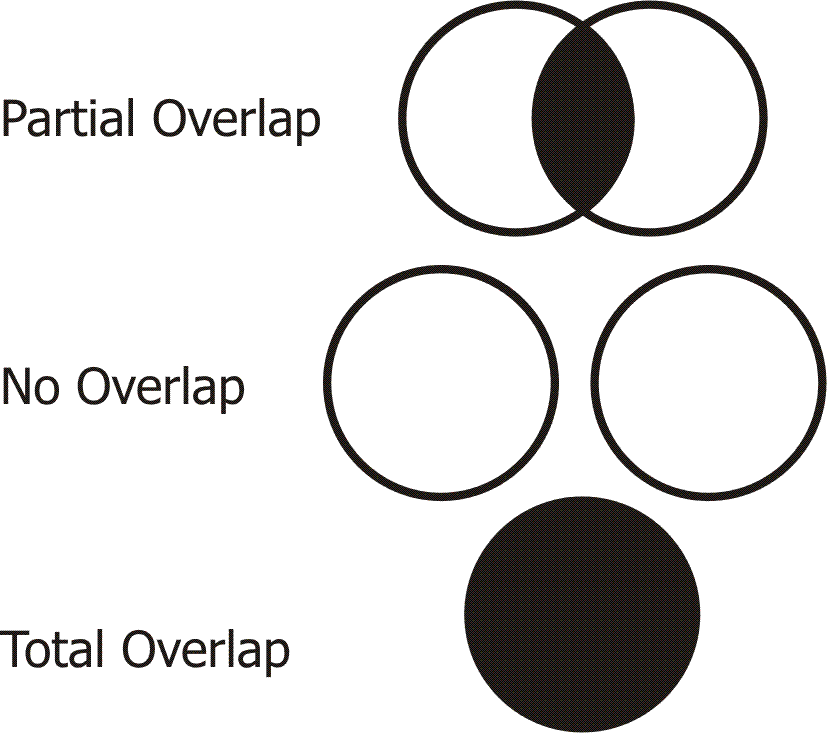
Element 9: Feedback
Feedback is the receiver’s response to the message. It provides the sender with a way to determine if the receiver received, interpreted and understood the message as it was intended. The message can be adjusted, should misunderstandings occur.
